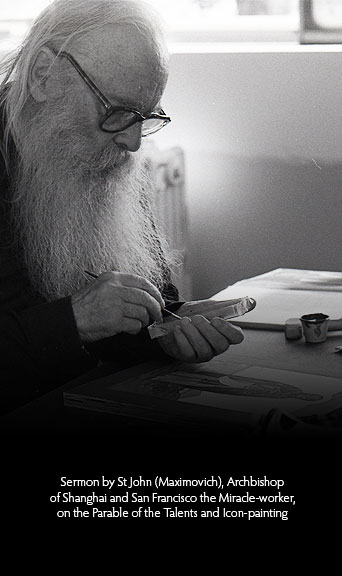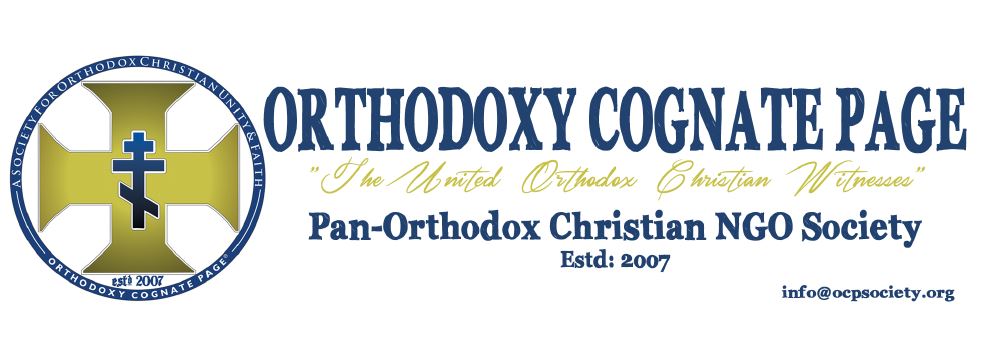
Sermon by St John (Maximovich), Archbishop of Shanghai and San Francisco the Miracle-worker, on the Parable of the Talents and Icon-painting
The Official Website of the Synod of Bishops of the Russian Orthodox Church Outside of Russia – September 2018
The Lord gave us a parable about a master who distributes talents to his servants corresponding with the abilities of each. After some time, he demanded of them reports on what they did and rewarded those who profited by the amount they were given. But the one who was idle and brought forth only the talent he was given was severely punished. The master in this parable is the Lord God, the talents are His gifts to us, and the servants are we people. The Lord grants us spiritual gifts, He gives them to individuals and to entire nations.
Before the coming of Christ, the words of God were entrusted to Israel. When Israel stumbled in faith, when Judea fell, the Prophet Baruch, student of Prophet Jeremiah, declared: “This is the book of the commandments of God, and the law that endureth for ever: all they that keep it shall come to life; but such as leave it shall die. Turn thee, O Jacob, and take hold of it: walk in the presence of the light thereof, that thou mayest be illuminated. Give not thine honour to another, nor the things that are profitable unto thee to a strange nation. O Israel, happy are we: for things that are pleasing to God are made known unto us” (Baruch 4:1-4).
Still, Israel did not remain in the commandment of God, and, rejecting the Son of God, fell from the Divine. The Lord founded His New Testament Church which was entered by many formerly pagan peoples. Byzantium became a special protector of Orthodox Christianity after the victory of Christendom over paganism, where the Ecumenical Councils and the Holy Fathers of the Church established the exact exposition of the dogmas of faith and Orthodox Christian teaching.
After the fall of Byzantium, the Orthodox Faith was primarily preserved by the Russian people, who had already fully absorbed its teachings. The ways of the people and the government laws and customs were all established upon Orthodoxy or in accord with it. One of the images of the Orthodox Faith is our churches, which covered the entire nation.
The church temple itself is an image of the unseen universal Church, which we refer to in the Creed: “And I believe in one Holy, Catholic and Apostolic Church.” That is why are temples are called “churches.” The church cupola that rises above the church turns our gaze to heaven and reminds us of the heavenly vaults towards which our prayers to God are lifted. It reminds us of the invisible heaven, the lofty Kingdom of God.
Churches are adorned with icons. Icons are not simply representations of someone or of some event. An icon is a symbol of the unseen. If we see in them the external appearance of Christ, of His saints, then the icon must reflect the inner Image, their holiness. Even lay representations often manifest one idea or another. Let us take the famous monument to Peter the Great in Petrograd, for instance, where he is depicted on a steed, which lifts up its rider, which symbolizes how high he lifted Russia up in many respects. Many other monuments likewise symbolize certain ideas. If in non-church art has such qualities, how much more must there be in images which depict something higher, heavenly, spiritual.
An icon is not a portrait; a portrait depicts the earthly image of a person, while an icon represents his inner state of being. Metropolitan Anastassy (Gribanovsky) of blessed memory once said how as a student in the Theological Academy, he and his fellow students attended the divine services of Fr John in Kronstadt. When Fr John concluded Liturgy, his face shone, like that of Moses when he descended from Mt Sinai. After some time, Fr John would receive them in his residence and appeared like a simple person. Our Lord Jesus Christ Himself once showed His Divine glory on Mt Tabor, but at other times He appeared as a simple man, so people were amazed at His power and miracles.
An icon must depict not only the external but the internal life, holiness and proximity to heaven. The main way this is depicted in the saint’s face and gaze, and the rest of the icon is painted on that basis. The image depicting the spiritual state hidden under the flesh was the intent of all our Orthodox icon-painters. The more successful this intention was manifested, the better the icon. There could be faults in the depiction of part of the body, not intentional, but because the main goal precluded them from focusing on lesser aspects of the image. We even see in un-staged photographs odd positions of the body which we usually don’t notice.
One cannot paint an icon by simply representing the physical body, it must represent unseen ascetic feats and it must shine with heavenly light. This can only be accomplished by someone who likewise lives a spiritual life, who understands and loves the lives of the saints. That is why our ancient icon-painters always approached their work with fasting and prayer. Many such icons were granted miraculous powers by the Lord.
Of course, every icon must be venerated after it is blessed, and it cannot be neglected or disrespected, so we refrain from judging icons hanging in churches, always seeking to observe not so much the external beauty of the icon but its spiritual quality. Icons which clearly do not satisfy the demands of Orthodox iconography should not be hung in the church or even at home.
Icons can be painted by those who have not mastered the craft or have an ability to paint. Often, the spiritual state of the painter and his desire to serve God has greater importance than the esthetic itself. After Peter the Great, along with the good that was brought from the West, there was a great deal of novelty, alien to the spirit of Orthodoxy, to which a large portion of the Russian intelligentsia succumbed, introducing some unwelcome and bad innovations. In part this applies to icon painting. Instead of emulating the old Russian iconographers, foreign artists of the West were copied. Though many new images were esthetically beautiful, they did not correspond to the spirit of icon painting. A spirit alien to Orthodoxy began inserting itself in Russia and gradually weakened her.
The words of the prophet apply to us: “Give not thine honour to another, nor the things that are profitable unto thee to a strange nation.” As in life, so in church traditions we must return to the firm and pure foundations upon which Russia was built and which maintained the nation. Our icons reflect them. Icons for our churches should be painted not in a spirit alien to Orthodoxy. Those who think that icons, however, should be painted in dark tones with physical distortions are wrong. Ancient icons were painted with bright colors, only becoming dark with time from dust and soot. But we should also remember that many saints were in fact dark-skinned, leading their lives in the wilderness, and that many of their bodies were emaciated from long years of ascetic life. They are glorified not with earthly but spiritual beauty.
May they help us with their prayers, so that our church temples would reflect heavenly glory, and may our flock unite in the search for the Kingdom of Heaven, and preach the truth of Orthodoxy in life and through our church temples.

